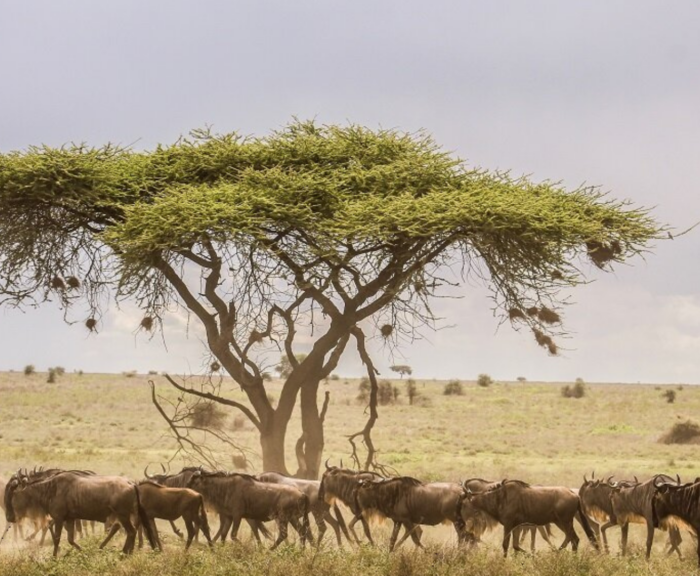Planning an African safari can be challenging, especially when determining the best time to go to Africa safari. Wildlife visibility and mosquito activity vary throughout the year, impacting your overall experience. This guide examines the dry and wet seasons in Tanzania and Kenya, offers a monthly breakdown of safari opportunities, and highlights key habitats like Etosha National Park. By understanding these factors, travelers can choose the optimal time to explore and fully enjoy the rich wildlife and stunning landscapes. This information ensures a well-timed safari, enhancing both comfort and adventure.
Understanding the Best Time for an African Safari
Seasonal variations and climate in Tanzania and Kenya play a crucial role in adventure travel and wildlife viewing. Regions like South Luangwa National Park are prime for cheetah sightings during specific times. Understanding these factors ensures travelers select the best period for an authentic Out of Africa safari experience.
Seasonal Variations in Tanzania and Kenya
During the dry months, the Ngorongoro Conservation Area offers exceptional opportunities to observe various mammals, including big cats, as wildlife gathers around limited water sources. Additionally, hot air balloon rides provide a unique vantage point to witness the behavior of these magnificent creatures, while interactions with the Maasai people enrich the safari experience with cultural insights.
Factors Influencing the Ideal Time for Wildlife Viewing
Several factors influence the optimal timing for wildlife viewing on an African safari, including climate patterns around Mount Kenya and regions like Rwanda, which enhance birdwatching opportunities and animal migrations. Selecting the right season allows travelers to stay at top safari lodges, ensuring prime access to wildlife habitats. Additionally, utilizing online resources with pingback features can provide up-to-date information, aiding in the planning of a memorable safari experience.
The Dry Season in Tanzania and Kenya
The dry season in Tanzania and Kenya offers optimal conditions for wildlife viewing as animals gather around limited water sources amidst sparse vegetation. Top destinations like Amboseli National Park and Ol Pejeta Conservancy become more accessible, enhancing safari experiences. Additionally, coastal areas along the Indian Ocean provide opportunities for activities such as snorkeling, making this period ideal for an African safari.
Wildlife Behavior During Dry Months
During the dry months, wildlife in Tanzania and Kenya congregates around the remaining water sources, providing excellent opportunities for observation and photography. This period is considered the best time to travel to Africa safari, similar to peak seasons in Botswana and South Africa’s Kruger National Park. Whether exploring the scenic Garden Route or the picturesque coast, travelers can enjoy enhanced wildlife encounters and stunning landscapes.
Optimal Parks and Reserves to Visit During This Time
During the dry season, Katavi National Park emerges as a top destination, allowing visitors to witness the Great Migration amidst breathtaking landscapes. Travelers from Johannesburg and even Central America find the park’s accessibility greatly improved as wildlife gathers around limited water sources, enhancing their safari experience. This prime time offers unparalleled opportunities to explore Tanzania and Kenya’s renowned reserves, ensuring memorable encounters with nature.
Advantages of Planning an African Safari in the Dry Season
Choosing to embark on an African safari during the dry season offers unparalleled opportunities in the Maasai Mara, where the Grumeti River becomes a focal point for wildebeest crossings and predator activity. The expansive wilderness is more accessible, allowing travelers to observe diverse wildlife with greater clarity and ease. Additionally, proximity to Bwindi Impenetrable National Park provides a unique opportunity to explore varied ecosystems, enhancing the overall safari experience.
The Wet Season in Tanzania and Kenya
During the wet season, Tanzania and Kenya offer unique safari experiences with rich birdwatching and lush landscapes, unlike those in South America. Parks such as Lake Manyara National Park and Selous Game Reserve are prime for observing wildlife migrations and hunting patterns. These conditions highlight diverse ecosystems, enhancing the African safari adventure.
Unique Experiences During the Wet Months
During the wet season, Lake Naivasha becomes a haven for bird enthusiasts, while game reserves in Tanzania and Kenya teem with herds taking advantage of abundant vegetation. Travelers can also explore nearby attractions like Victoria Falls, which are majestic during heavy rains. These unique conditions provide rich wildlife viewing and vibrant landscapes, making the wet months a rewarding time for safari adventures.
Recommended Parks for Birdwatching and Lush Landscapes
During the wet season, parks like Lake Manyara National Park near Arusha become a paradise for birdwatchers, as seasonal floods transform the landscape into vibrant habitats teeming with avian life. This period is considered the best time to go safari for those interested in observing a diverse range of bird species and enjoying lush, green scenery. Travelers can witness rare migratory birds and experience the rich biodiversity that thrives when the region receives ample rainfall.
Wildlife Migration Patterns in Wet Season
During the wet season, wildlife migration patterns around the Mara River and nearby lakes become more pronounced, highlighting why this period is among the best time to visit Africa safari in Tanzania and Kenya. The increased water flow in the Mara River supports larger herds moving through the region, while areas near the Luangwa River offer additional habitats for diverse species. Additionally, the lush surroundings of Diani Beach provide a unique backdrop for observing these migrations, enhancing the overall safari experience with abundant wildlife and vibrant landscapes.
Monthly Breakdown of Tanzania’s Safari Seasons
The monthly breakdown of Tanzania’s safari seasons covers January to March for early wildlife highlights, April and May with the onset of rains impacting savanna and rainforest regions, June to August as the peak safari months in areas like the Great Rift Valley and Chobe National Park, and September to December when wildlife behavior transitions. Destinations such as Lamu offer unique experiences throughout these periods.
January to March – Early Year Wildlife Highlights
From January to March, Tanzania’s Serengeti National Park and Ruaha National Park are teeming with wildlife, providing visitors with exceptional viewing opportunities as the landscapes remain lush from the rainy season. In neighboring Zambia, the Zambezi region offers diverse habitats that enhance the early year safari experience with a variety of animal species. Additionally, Tarangire National Park continues to be a top choice during these months, allowing travelers to explore vibrant ecosystems and observe dynamic wildlife behaviors.
April and May – The Onset of Rains and Its Effects
In April and May, the onset of rains in Tanzania and Kenya triggers vibrant bird migration at Lake Nakuru, creating prime opportunities for photography enthusiasts. The increased rainfall fosters lush landscapes that attract a diverse array of wildlife, enhancing the overall safari experience. Additionally, nearby regions like Uganda and areas resembling the Okavango Delta offer extended opportunities for observing dynamic ecosystems and rich biodiversity.
June to August – Peak Safari Months
June to August marks the peak safari season in Tanzania, offering unparalleled wildlife sightings in top destinations like the Serengeti and the Ngorongoro Crater. During these months, the dry climate enhances visibility and accessibility, making it the best time of year to go on safari. Additionally, regions such as Samburu National Reserve in Kenya and the expansive landscapes of Namibia‘s Kalahari Desert provide diverse experiences, ensuring travelers have a comprehensive and memorable adventure.
September to December – Transitioning Wildlife Behavior
From September to December, as the dry season concludes in Tanzania and Kenya, wildlife behavior begins to transition, with animals adapting to the changing availability of resources. Areas around Lake Natron become bustling with activity, attracting diverse species, while nearby southern Africa reserves like Moremi Game Reserve see increased sightings of chimpanzees and other primates. This period offers safari enthusiasts the chance to observe dynamic interactions and a wide range of wildlife as the ecosystem evolves.
Monthly Breakdown of Kenya’s Safari Seasons
Kenya’s safari seasons span the year, each month offering distinct experiences. January and February are perfect for exploring the plains near Mount Kilimanjaro, while March to May bring rains that influence species behavior. June to October highlight the Great Migration‘s significance, and November to December provide calm post-rains, ideal for visits to Mombasa and areas bordering Zimbabwe.
January and February – Exploring the Plains
January and February present prime opportunities for exploring Kenya’s vast plains around Nairobi and Naivasha, where abundant antelope herds roam freely under clear skies, making it an excellent time for a wildlife-focused vacation. The mild climate during these months allows for comfortable game drives, offering visitors unforgettable sightings and immersive safari experiences. Additionally, travelers can complement their African adventure by visiting Cape Town, seamlessly blending vibrant city life with the tranquility of Kenya’s natural landscapes.
March to May – Impact of the Rain Season on Wildlife
From March to May, the rain season brings higher humidity levels to Kenya, influencing wildlife behavior across key areas such as Nairobi National Park, Tsavo, and the Serengeti. During this period, Hwange National Park experiences shifts in animal migration patterns, allowing visitors to witness unique interactions and vibrant landscapes. Travelers can take advantage of the lush scenery and more active wildlife, making it an ideal time for a memorable safari experience.
June to October – The Great Migration and Its Significance
From June to October, East Africa becomes the epicenter of wildlife action with the Great Migration, where millions of wildebeest and zebras traverse the Serengeti and Maasai Mara in search of fresh grazing grounds. This period offers unparalleled opportunities for safari enthusiasts to witness one of nature’s most remarkable spectacles, enhancing their African adventure with memorable wildlife encounters. Additionally, coastal areas in East Africa may allow sightings of whales, adding to the diverse wildlife experiences available during this peak safari season.
November and December – Calming After the Rains
November and December in Kenya present a tranquil period for an African safari, as the rains subside and wildlife becomes more accessible around dwindling water sources. This season offers visitors the chance to experience vibrant landscapes and diverse animal interactions with fewer tourists, enhancing the overall safari adventure. Travelers can take advantage of the improved visibility to capture memorable wildlife sightings and fully immerse themselves in Kenya’s rich natural beauty.
Tips for Planning Your Safari
Planning a safari in Tanzania and Kenya requires selecting packages suited to the season, preparing essential gear for varying weather conditions, and understanding peak tourist times to manage crowd levels. These tips ensure a well-organized and enjoyable African safari, enhancing wildlife viewing and overall travel experience.
Selecting the Right Safari Package for the Season
Selecting the right safari package for the season involves aligning travel dates with peak wildlife activity in Tanzania and Kenya. For instance, choosing a package during the dry season ensures easier wildlife spotting as animals gather around water sources. Additionally, packages that include guided game drives and knowledgeable local guides can enhance the overall experience by providing expert insights into animal behavior and regional ecosystems. By carefully matching the safari package features with the seasonal advantages, travelers can maximize their opportunities for memorable wildlife encounters and a fulfilling African adventure.
Essential Gear and Preparations for Different Seasons
Equipping appropriately for an African safari in Tanzania and Kenya is crucial for a comfortable and enjoyable experience across different seasons. During the dry months, travelers should prioritize lightweight, long-sleeved clothing, sun hats, and high-SPF sunscreen to protect against intense sunlight, while sturdy binoculars and cameras with telephoto lenses enhance wildlife viewing and photography. In the wetter seasons, waterproof gear, quick-dry apparel, and durable footwear are essential to navigate rainy landscapes, ensuring preparedness for varying weather conditions and maximizing the safari adventure.
Understanding Peak Tourist Times and Crowd Levels
Understanding peak tourist times and crowd levels is essential when planning an African safari in Tanzania and Kenya. Traveling during less busy periods can result in a more intimate wildlife experience, with fewer visitors and better chances of spotting animals. By avoiding peak seasons, travelers may also benefit from more competitive pricing and greater availability of accommodations, enhancing their overall safari adventure.
Conclusion
Choosing the best time for an African safari in Tanzania and Kenya is essential for maximizing wildlife sightings and enjoying optimal travel conditions. During the dry season, animals congregate around water sources, making them easier to observe and photograph. The wet season offers lush landscapes and diverse birdlife, providing a different but equally rewarding safari experience. Planning your trip according to seasonal variations ensures a memorable and enriching adventure in these renowned safari destinations.



